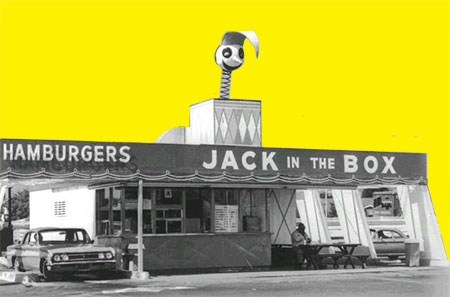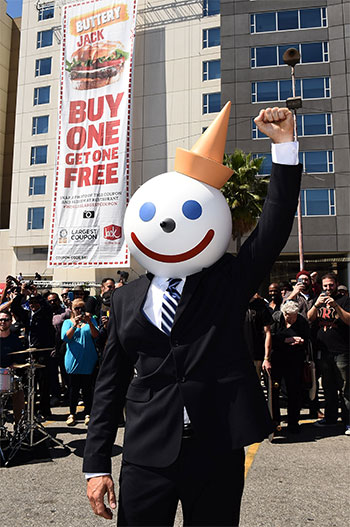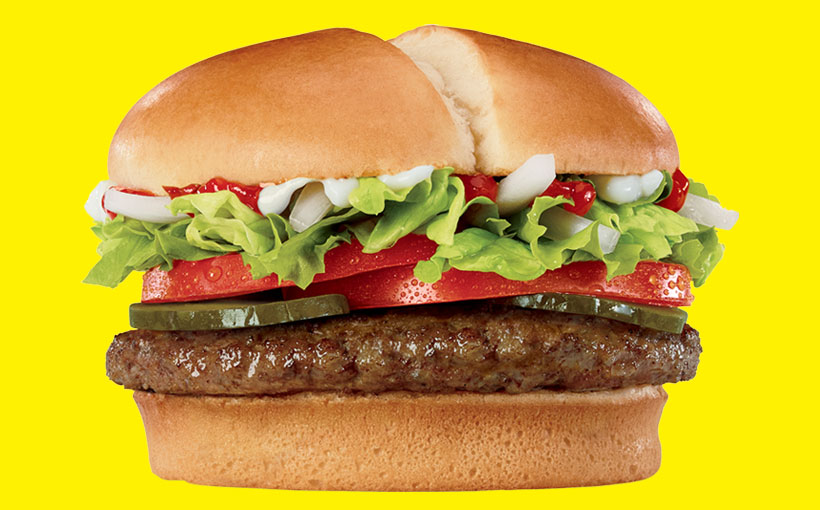You may have a favorite Jack in the Box commercial, an antenna ball of its clown-headed mascot, or a secret love for its fried tacos. But you might not know the fast-food giant has humble beginnings in San Diego, and has been based here for almost 70 years. The company not only has some of the most creative marketing in the industry, it developed a lot of fast-food firsts, especially in technology.
1950s
1951
 Robert O. Peterson opens the first Jack in the Box at 63rd Street and El Cajon Boulevard in Rolando. It was the first drive-thru restaurant in San Diego to have a two-way intercom. A hamburger cost 18 cents (about $1.72 after inflation).
Robert O. Peterson opens the first Jack in the Box at 63rd Street and El Cajon Boulevard in Rolando. It was the first drive-thru restaurant in San Diego to have a two-way intercom. A hamburger cost 18 cents (about $1.72 after inflation).
Mid-1950s
Tacos are added to the menu. Today they’re the company’s most popular item, selling 554 million a year. Every aspect of the taco, from formula to cooking method, is patented.
1960s
“We have never seen a need to relocate from our roots.”
—Iwona Alter, Chief Marketing Officer
1960
Opens first restaurant outside of California, in Phoenix.
1963
Headquarters is established in Kearny Mesa, where it remains today. Why stay in San Diego? Alter says the company’s focus on pushing boundaries, and the Asian and Mexican influences in its menu, are very aligned with West Coast values.
1965
Company is incorporated. It has more than 200 locations and rapidly expands.
1969
First fast-food restaurant to add a breakfast sandwich to the menu. It’s renamed the Breakfast Jack three years later.
1970s
1971
Introduces the Jumbo Jack hamburger.
1980s
1980
Changes its marketing campaign and logo to appeal to older, more affluent customers. A commercial shows its mascot, Jack, being blown up.
1982
Adds portable salads to the menu, another industry first.
1990s
A Decade of Trial and Triumph
1993
Health officials trace an outbreak of E. coli that infected hundreds of people in four states to ground beef in Jack in the Box hamburgers. It results in a government investigation, new regulations in the beef industry, and national policies on food safety.
1994
 An article in the Los Angeles Times says the company’s image is in shambles: “The name Jack in the Box became the fast-food equivalent of Exxon after the Valdez oil spill.”
An article in the Los Angeles Times says the company’s image is in shambles: “The name Jack in the Box became the fast-food equivalent of Exxon after the Valdez oil spill.”
1993–94
The company overhauls its entire operation, and hires Dave Theno, a microbiologist, to set new safety standards—that have since been adopted across the industry—such as testing all of its beef for microbes.
1995: “Jack’s Back”
The old mascot is reimagined by ad exec Rick Sittig as a clown-headed, suit-wearing company CEO who makes his first commercial appearance by blowing up a boardroom.
1995
Antenna balls resembling Jack’s head are given away at the restaurants as a promotion for the Sourdough Jack burger. More than 32 million antenna balls have been given to date.
1996
Jack runs for president, beating Bill Clinton in a virtual poll. The company grows to 1,000 restaurants.
2000s
2004
A 70,000-square-foot “Innovation Center” opens in Kearny Mesa, housing the company’s marketing department and test kitchen, which has custom-made, proprietary ovens (which we weren’t allowed to photograph!)
2005
Linda Lang is named CEO—one of 20 female CEOs of a Fortune 1000 company.
2010s
Late 2013
Launches “Jack’s Munchie Meal,” a new late-night menu whose cheeky marketing campaign brings the company tons of media attention, and eventual praise from Wall Street: Late-night sales skyrocket and stock shoots up by 73 percent.
Late 2013
Alter says the company just leaned into what it’s known for when developing Jack’s Munchie Meal. “If we are already seen as this 24-hour, late-night place, what could we do to bring even more attention to that?”
2014
Linda Lang retires, and Leonard Comma is named CEO.
2016
Releases the first VR fast-food commercial, for its Brunchfast menu. Jack in the Box and Qdoba combined have almost 3,000 restaurants.
2017
Becomes the first fast-food restaurant to ink a deal with DoorDash, a third-party food delivery startup. Some of the app’s users in Los Angeles have their food delivered by former NFL wide receiver Terrell Owens, who drives a red van marked “Crave.”
The Future
There’s been talk of automation in the fast-food industry, of workers being replaced by kiosks or even robots. “Being in the hospitality industry, I don’t think that the interaction with a human being can be replaced by a robot,” Alter says. Rather, the future is all about the mobile phone. “Guests interact with us (the brand) through their mobile devices; that’s what we have been paying attention to.” They’re also dabbling in voice-recognition ordering.
Fun Facts
A prime parking space in front of the company’s Kearny Mesa headquarters is marked “Jack’s Spot.”
Jack was voiced by Rick Sittig, an ad exec from Secret Weapon Marketing in Santa Monica who reinvented the character, from 1995 until 2015.
It takes anywhere from six months to two years for the company to add a new item to the menu. As many as two dozen different versions of a burger could be created before it’s narrowed down and tested in focus groups.
The Innovation Center has a “sensory room” with a two-way mirror where executives and reps from partnering companies, like Coca-Cola, watch volunteers taste new menu items.
“Jack’s Back” is the longest ongoing advertising campaign in the fast-food industry.
Sources: New York Times, Los Angeles Times, Food Safety News, The Motley Fool
Tags: Business, Fast Food, Jack in the Box






























